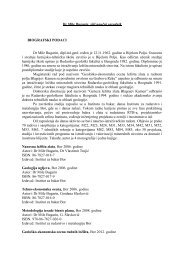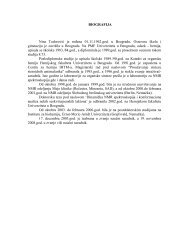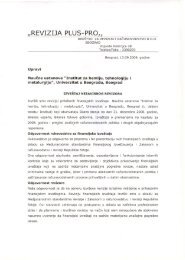Радно искуство - IHTM - Универзитет у Београду
Радно искуство - IHTM - Универзитет у Београду
Радно искуство - IHTM - Универзитет у Београду
Create successful ePaper yourself
Turn your PDF publications into a flip-book with our unique Google optimized e-Paper software.
D. MARINKOVIĆ et al.: MOTOR FUEL CONSUMPTION IN SERBIA Hem. ind. 66 (3) 413–423 (2012)<br />
lars, calculated at the time of writing this paper (current<br />
international USD) [12]. The second parameter is<br />
the amount of consumption of motor fuels. The linear<br />
correlation of these two parameters in the model is<br />
modified by introducing some correction factors. Their<br />
contribution in this model was evaluated according to<br />
their specific impact on consumption and some of them<br />
according to the specifics of the transport sector in<br />
Serbia.<br />
Therefore, the development of motor fuel consumption<br />
for one country cannot be correlated exclusively<br />
and only with the growth of GDP. Factors affecting<br />
are the level of motorization (number of registered<br />
motor vehicles) and, average fleet mileage in passenger<br />
and freight traffic, degree of modernization and growth<br />
of the fleet, technological and technical progress which<br />
leads to reduction of specific consumption of motor<br />
fuels (energy efficiency of vehicles), the number of vehicles<br />
with air conditioning, development of the relations<br />
of consumption gasoline/diesel fuel, the level of<br />
substitution of fossil fuels to alternative fuels, industrial<br />
growth, the policy of state regulations, subvention in<br />
the energy sector, tax and price policy, etc. A particularly<br />
important factor is, of course, the level of price<br />
of motor fuels – when taking into account the longer<br />
term trends, instead short term variation that has<br />
smaller impact (as is the case recently when the price<br />
of crude oil in the two-year period, driven on from 60<br />
to 150 USD and then to 35 USD and finally in the first<br />
quarter of 2011 to 100 USD per barrel).<br />
METHODOLOGY<br />
A mathematical model was developed using available<br />
statistics of the Republic of Serbia, neighbouring<br />
414<br />
countries and European countries that have made transitions<br />
similar to that Serbia is now undergoing, as well<br />
as data published by the relevant institutions in the<br />
energy sector and scientific and review papers. This<br />
task was initially meant to be a selection and application<br />
of analytical techniques for the analysis of past<br />
trends in consumption of motor fuels and intensity of<br />
traffic in Serbia. Then, analyzing the existing motor fuel<br />
demand projections was performed for the countries<br />
or regions of similar size and level of development,<br />
with similar characteristics of supply and demand of<br />
petroleum products, in order to reach the relevant analogy.<br />
Going forward, the identification of factors affecting<br />
the consumption of motor fuels that can be<br />
quantified based on statistical data was approached. In<br />
the absence of an adequate database from the energy<br />
and transport sectors in Serbia, some of the qualitative<br />
impact factors on fuel consumption were quantified by<br />
an assessment of particular concern, as will be explained<br />
in the part of parameter identification in this<br />
paper.<br />
Modelling of motor fuel consumption in Serbia is<br />
based on the correction of linear dependence of the<br />
volume of total consumption of motor fuels and the<br />
level of GDP PPPPC, identified in the period of 2001–<br />
–2009. Justification for the assumption of the existence<br />
of linear correlation of GDP per capita and consumption<br />
of motor fuels, in addition to the conclusions of<br />
many authors [2,6], can be found in time series analysis<br />
of relevant statistical data for Serbia. Figure 1 clearly<br />
illustrates the strong positive correlation of these two<br />
variables. Statistical analysis shows that the correlation<br />
coefficient between total consumption of motor fuels<br />
and GDP PPPPC is 0.94.<br />
Figure 1. Correlation between gross domestic product per capita calculated at purchasing power parity (GDP PPP PC) and total<br />
consumption of motor fuels in Serbia in the period 2001–2009.







